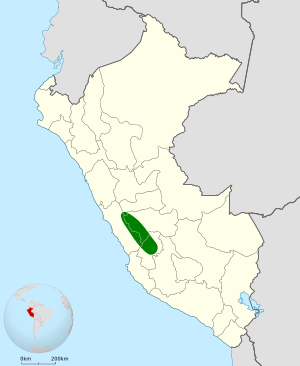White-bellied cinclodes facts for kids
Quick facts for kids White-bellied cinclodes |
|
|---|---|
 |
|
| Conservation status | |
| Scientific classification | |
| Genus: |
Cinclodes
|
| Species: |
palliatus
|
 |
|
The white-bellied cinclodes (Cinclodes palliatus) is a special type of bird. It belongs to the ovenbird family, called Furnariidae. This bird lives only in Peru, making it endemic to that country. You can find it in high, wet grasslands in the Junín Region. It might also live in the Huancavelica Region.
This bird is quite large for an ovenbird. It has dark feathers on its back and bright white feathers on its belly. The white-bellied cinclodes is a very rare bird. It needs a very specific kind of home, and its habitat is being destroyed. Because of this, the International Union for Conservation of Nature says it is "critically endangered". This means it is at a very high risk of disappearing forever.
Contents
About the White-bellied Cinclodes
The white-bellied cinclodes is bigger than other birds in its group. It also has a longer tail. It looks more like a mockingbird than a typical Cinclodes bird. This bird grows to be about 24 centimeters (9.4 inches) long.
Its head is brownish-grey. Its back and wings are a reddish-brown color. It has a wide white stripe on its wings. The feathers on its belly are pure white. The song of this bird is a fast, chattering sound. It sounds like "pipipipipi pi pi". Sometimes, it gets faster and higher-pitched, like "wee wee wee wee wee".
Where These Birds Live
This special bird is only found in a high mountain area of Junín Region in Peru. People used to think it also lived in the Huancavelica Region. However, recent searches there have not found any.
The white-bellied cinclodes needs a very specific type of home. It lives in wet, mineral-rich bogs. These bogs often have cushion plants like Distichia growing there. There also need to be rocky cliffs and slopes nearby. These birds live at very high altitudes. They can be found from about 4,430 meters (14,530 feet) up to the snowline, which is around 5,000 meters (16,400 feet). Even though there are many places that look like good homes for them, these birds are not found everywhere.
How They Live and What They Eat
White-bellied cinclodes birds usually look for food in pairs or small groups. They push their beaks into the wet ground. They are looking for worms and other small creatures without backbones. These are called invertebrates.
We don't know much about how they raise their young. However, their nests are usually hidden inside cracks in rocks.
Protecting the White-bellied Cinclodes
In 2003, experts guessed there were only about 200 to 1,000 of these birds left. They did not find any new places where the birds lived. More surveys were done between 2008 and 2011. They visited 104 bogs and found 113 birds living in 18 of them. This led to a new guess that there are fewer than 300 white-bellied cinclodes birds in total.
Their homes are being harmed by several things. Mining activities and waste from mines are a problem. People are also digging up peat from the bogs. Also, too many alpacas, llamas, and sheep are eating the plants there. This is called overgrazing. If these problems continue, the future for these birds looks very difficult. Because of this, the International Union for Conservation of Nature has said they are "critically endangered." This means they are in great danger of becoming extinct.
See also
 In Spanish: Remolinera ventriblanca para niños
In Spanish: Remolinera ventriblanca para niños


